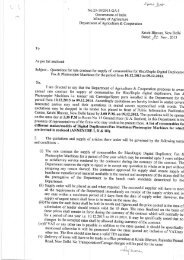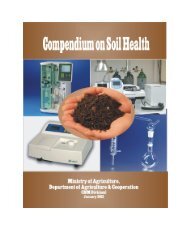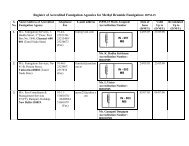canopy management in fruit crops - Department of Agriculture & Co ...
canopy management in fruit crops - Department of Agriculture & Co ...
canopy management in fruit crops - Department of Agriculture & Co ...
Create successful ePaper yourself
Turn your PDF publications into a flip-book with our unique Google optimized e-Paper software.
Plum<br />
Plum plants are slower than that <strong>of</strong> peach and they take longer time to come <strong>in</strong>to<br />
bear<strong>in</strong>g. Therefore, their framework should be developed similar to that <strong>of</strong> apple with<br />
modified leader system. Prun<strong>in</strong>g <strong>of</strong> mature trees should <strong>in</strong>clude removal <strong>of</strong> diseased and<br />
dried wood, removal <strong>of</strong> brush wood, elim<strong>in</strong>ation<br />
<strong>of</strong> weak crotches, th<strong>in</strong>n<strong>in</strong>g out <strong>of</strong> bear<strong>in</strong>g wood<br />
to allow penetration <strong>of</strong> light, spray materials, etc.<br />
keep<strong>in</strong>g the trees at reasonable height to facilitate<br />
harvest<strong>in</strong>g. Head<strong>in</strong>g back and th<strong>in</strong>n<strong>in</strong>g out <strong>of</strong><br />
shoots may also be done to develop either new<br />
growth or spurs for <strong>fruit</strong><strong>in</strong>g, as the case may be,<br />
with different varieties.<br />
•<br />
•<br />
•<br />
•<br />
•<br />
•<br />
•<br />
Plum plants are generally tra<strong>in</strong>ed accord<strong>in</strong>g to<br />
their growth habit and vigour <strong>of</strong> rootstock.<br />
Tra<strong>in</strong><strong>in</strong>g is done to give a proper shape and to develop a strong framework <strong>of</strong><br />
branches.<br />
Plum trees are mostly tra<strong>in</strong>ed <strong>in</strong> open centre leader and modified centre <strong>canopy</strong>.<br />
The top <strong>of</strong> plant is headed back to 60-80cm to stimulate the growth <strong>of</strong> lateral branches<br />
at the time <strong>of</strong> plant<strong>in</strong>g. Dur<strong>in</strong>g first summer, 3-5 scaffold branches around the ma<strong>in</strong><br />
stem are selected.<br />
Lowest scaffold branches should be about 30cm above the ground level, while other<br />
scaffolds should be 15cm apart <strong>in</strong> spiral order. Only wide angled branches should be<br />
selected, while rema<strong>in</strong><strong>in</strong>g ones are p<strong>in</strong>ched <strong>of</strong>f.<br />
In the first dormant prun<strong>in</strong>g, central leader is headed back and scaffold branches<br />
are allowed to grow whose one third growth is removed. Other weak and unwanted<br />
branches on the ma<strong>in</strong> stem are also pruned <strong>of</strong>f.<br />
Well tra<strong>in</strong>ed plants<br />
In the second dormant prun<strong>in</strong>g, 2-3 well spaced secondary branches are selected on<br />
each primary scaffold whose one third to one fourth portion is pruned <strong>of</strong>f.<br />
Canopy Management <strong>in</strong> Fruit Crops 69

















